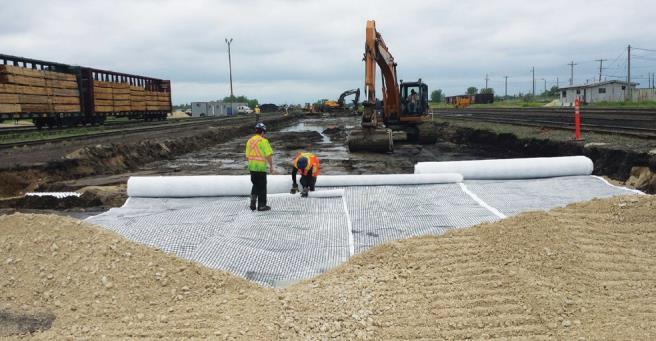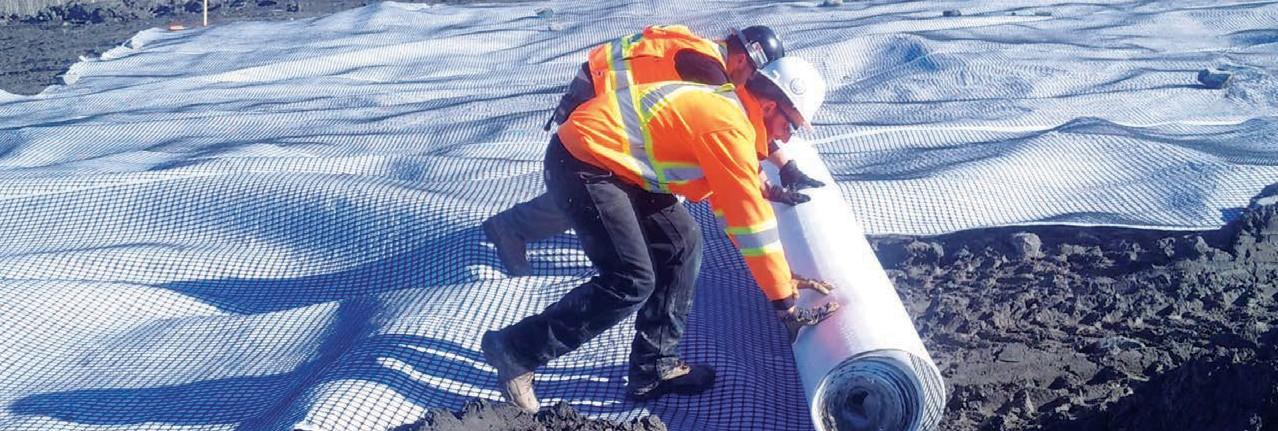On solid ground: Spotlighting Titan’s geosynthetics
Successful construction projects begin on solid foundations. That’s not always a given on sites where weaker subgrades make it difficult, if not impossible, to stage the equipment, materials, and people for the job. This is a scenario that roadbuilders and contractors across the industry can run up against. It’s also one in which advanced geosynthetics can lead to sturdier and more sustainable outcomes.
Geosynthetics are not new to the industry. Suppliers like Titan Environmental Containment (Titan), however, have been working over the years to bring specialized skills and innovation to the space. And beyond delivering geogrid solutions for roadbuilding initiatives, the company’s products are used to resolve and enhance difficult infrastructure projects across Canada.
Mine the road

Titan’s contributions to a mine haul road construction project in Ontario’s North is a compelling case study. The site featured compacted clay with a blast rock/granite base course, which meant the road would be unreinforced at the interface of the sub-base and the subgrade, resulting in the lateral movement of particles. With the conditions, the project team recognized that mining-related pumping action would cause sub-base failure, and repetitive heavy dump truck traffic over the weak subgrade would result in a higher differential settlement.
“The road was full of weak soil through to the subgrade,” recalls Sam Bhat, Vice President of Global Business Development & Chief Technical Officer, Geosynthetics with Titan. “Typically, what you’d do in that case is apply a thick layer of granular on the road and compact as well. However, the problem with that approach was that the main subgrade was so weak that equipment still got stuck on that thicker layer of granular and couldn’t move.”
Mounting frustrations led the project team to Titan. And after performing its own calculations and assessments of the subgrade soil, Bhat and his team recognized that reinforcement and separation functions were required for optimal road performance. To that end, Bhat proposed installing Swamp Grid™ 40 at the bottom of the aggregate base layer.
“We selected this product because it’s a combo material with a geotextile and a high stiffness geogrid on the top,” says Bhat. “Placing this composite grid on the clay subgrade created a stiff working platform. Now, they could move the equipment and walk on the surface without difficulty.”
The benefits of Titan’s solutions were quick to surface. In addition to helping the project team conduct their work and stick to their timelines, it provided a road base that minimized the loss of aggregate into the soft subgrade during construction while also preventing the penetration of individual aggregate particles into the soft subgrade under repeated traffic loads. Moreover, the Swamp Grid™ required a thinner aggregate base (0.7 m thick vs. 1.0 m), resulting in approximately $1M in savings to the project, and a reduced environmental footprint.
Back on track
Titan’s Swamp Grid™ 30 proved equally advantageous during a six-track railway extension project at the Canadian National Rail’s Transcona yard in Winnipeg, Manitoba. Swampy soil conditions made it difficult for crews to place the capping layer required to move forward with work. There was also concern that building a railway track over soft and plastic subsoils would lead to progressive sheer failure and excessive plastic deformation, effectively reducing efficiency and adding ongoing maintenance costs.
“They wanted to add an additional track with a very heavy load over this very weak and saturated soil,” says Bhat. “The weakness of this subgrade was such that a person standing on it would sink nearly six inches. They could not even bring equipment on it to get started.”
Once again, Titan was hired to move the project to solid ground. After several consultations, Bhat proposed using Swamp Grid™ 30 over the weak and saturated subgrade and placing and compacting a 600 mm thick granular (< 50 mm limestone) capping/sub-ballast layer above it.
“That was back in 2014 and the project continues to hold up extremely well today,” reports Bhat, adding, “Again, we were able to come in, assess the situation, and install a geogrid composite that reduces maintenance, reduces sub-ballast thickness, and minimizes differential settlements – all of which contributes to greater savings and a long-lasting, high-performance surface.”
These case studies demonstrate how bringing geogrid materials and specialists into the fold can get any project off on solid footing, be it a road, track, or any number of infrastructure initiatives.
Read Innovations in Road Building: The Geogrid Advantage for more case studies, and visit +Titan Environmental Containment (Titan) for more solutions.
